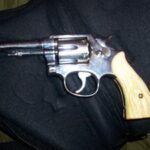In 1852, partners Horace Smith and Daniel B. Wesson produced their first lever-action pistol. Over the next 155 years, they would produce many pistols that would change the course of history, such as the Model 36 “Chief’s Special”, the Centennial, and the .44 Magnum Model 29 (the Dirty Harry special). Few pistols they produced would prove to be as popular and controversial as the Sigma series semi-automatic pistols.
These double-action-only (self-cocking) pistols mark S&W;’s first use of synthetic materials for pistols. The frame is made of a high-strength polymer material with the serial number and a barcode embedded under the muzzle just before the trigger guard. Their construction and action are so similar to Glock’s pistols (earning them the nickname “Swock”), that Glock sued Smith and Wesson for patent infringement.
They paid them an undisclosed sum for the infringements, which allowed them to continue producing the Sigmas, but had to redesign the trigger mechanism to keep Glock from suing them again.
Anyhow, enough with the history lesson, and on with the review: The Sigma pistol comes with a black polymer frame with a choice of a black or silver slide. The mid-nineties models come in four variations; Full Size models (with a 4 1/4 inch barrel) SW9F and SW40F (9 mm and .40 S&W; calibers respectively, and compact models (with a 3 3/4 barrel) SW9C and SW40C.
The weapon holds 15 rounds in the magazine (pre-2002 models hold only 10) plus one in the chamber. The safety is integrated into the trigger mechanism, which means the pistol cannot be fired unless the trigger is squeezed intentionally. The recoil isn’t that bad, because each spent round is ejected from the breech every time a round is fired.
The are a little tougher to aim (at least for me) at more distant targets, because of the large bore and small barrel, but they are very effective in the short-range, with a knockdown power that will stop any menacing intruder. Seriously, I am a much better shot with longer-barrel big-bore guns like the 9mm Berettas and Rugers. But the knockdown power of these babies is why they’re the weapon of choice for law enforcement
Field stripping these sidearms is a little tricky, though. The barrel stop on the slide is very small and has a very tight spring. It takes several tries if you’re not used to removing the slide, and that can make your fingertips very sore. But once it’s off, removing the recoil spring and the barrel is a snap, and, luckily, reassembling it is much easier than taking it apart.
It is also easy to clean, which should be done as soon as possible after firing. Gunshot residue (GSR) is extremely caustic, and will pit the inside of the barrel and chamber, which weakens the metal, and makes the weapon unsafe. Just a wire bore brush and a wool swab in the PROPER caliber with some good cleaning solution in a WELL-VENTILATED area will make the inside of the weapon shine. Don’t forget to apply a thin coat of oil to protect against corrosion.
Lubrication is a snap. Just apply one small drop of oil to both ends of the barrel and to each of the four points of the frame where the slide makes contact. Do not over lubricate, because too much oil can cause GSR to adhere more firmly to the inside of the weapon. Just a little drop will do for the Sigma.
As far as semi-automatic pistols go, the Sigma is one of my favorites. The polymer frame makes it feather-light, and firing it is like holding a little hand cannon. It does much better at close range than for distance shooting, and, of course, the full-sized Sigmas are more accurate than the compacts, although the latter are easier to conceal. Like the Glock, it is affordable personal and home protection, retailing for between $350 and $400 new, and about $275 to $325 used.





